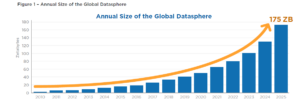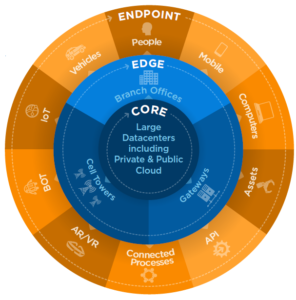
Global DataSphere to Hit 175 Zettabytes by 2025, IDC Says

(spainter_vfx/Shutterstock)
The data we have now is huge. But size, it turns out, is a relative thing. And according to the IDC, the sum of the world’s data – the DataSphere — will grow from 33 zettabytes in 2018 to a mind-boggling 175ZB by 2025.
That robust 61% compound annual growth rate for data came out of IDC‘s latest “Data Age 2025” whitepaper, where it laid out its latest research into the phenomenal growth of data and the impact of digitization on the world around us. The 175ZB figure is 9% higher than the 2025 forecast the IDC released last year.
The new report, which was sponsored by hard drive maker Seagate and can be accessed here, contained several eye-opening findings about the projected state of big data in 2025, including:
- The storage industry will ship 42ZB of capacity over the next seven years;
- 90 ZB of data will be created on IoT devices by 2025;
- 49% of data will be stored in public cloud environments by 2025;
- and nearly 30% of the data generated will be consumed in real-time by 2025;
IDC defines the DataSphere as being composed of three locations. First, there’s the “core,” which includes traditional and cloud data centers. Then there’s the “edge,” which includes enterprise-hardened infrastructure like cell towers and branch offices. Lastly, there are “endpoints,” which include PCs, smart phones, and IoT devices.
IDC’s tally of the DataSphere doesn’t differentiate events in the lifecycle of a particular piece of data, including when it’s created or captured, when it’s replicated or transferred, and when it’s ultimately consumed or viewed. Thus, the same fundamental piece of data could count several times – or a million times, as is the case of popular cat memes.
Trying to fathom this much data is obviously beyond our human abilities. But IDC’s David Reinsel gives it a whirl nonetheless.
“If one were able to store 175ZB onto BluRay discs, then you’d have a stack of discs that can get you to the moon — 23 times,” Reinsel says in a video released with the whitepaper. “Even if you could download 175ZB on today’s largest hard drive, it would take 12.5 billion drives. And as an industry, we ship a fraction of that today.”
We use a mix of different media to store today’s DataSphere, and that mixed approach will continue into the future. Interestingly, the mix isn’t forecast to change considerably over the coming years, although the allotments will shift a bit.
IDC projects that we’ll continue to store the majority on data on traditional spinning hard disk drives (HDD), with solid state drives (SSDs) grow quickly too. Super-fast memory-like NVM-NAND technology is projected to grow quickly in the coming years as prices come down, and IDC also sees “NVM-Other” starting to emerge in 2023.
Tape drives are often disparaged as legacy storage media, but tape use is actually projected to grow considerably by 2025. Optical storage, such as BlueRay discs, is projected to remain fairly constant.
The amount of data being generated far exceeds our ability to store it. That has been the case for a while, and it will continue to be the case going forward. However, the location of our data stores is forecast to undergo a transformation in the coming years.
According to IDC, by 2024, the amount of data stored in the core will be more than double the amount stored in the endpoint, “completely reversing the dynamic from 2015,” the analyst group writes. “Edge storage will also see significant growth as latency-sensitive services and applications proliferate throughout our world.”
Public cloud services such as AWS, Azure, and GCP will account for the lion’s share of that storage growth, and much of the DataSphere will end up on the cloud. “By 2020, IDC believes that the public cloud will have more data stored than in consumer devices, and by 2021, the cloud will have more data than in traditional data centers.
The shift to “real time” data (as opposed to data describing something that occurred in the past) is another phenomenon that will start to accelerate in the coming years. According to IDC, the average person will have more nearly 5,000 digital interactions per day by 2025, up considerably from the 700 to 800 or so that people average today.
IDC also introduced something called the Data Readiness Condition Index, or the DATCON, with this issue of the DataSphere series. Organizations that are well-positioned across various metrics for the ongoing digitalization of industries, business, and society would be considered “optimized” and would rate a top score of 5 on the index, while an organization that has largely failed to prepare would be considered “critical” and would score a 1.
The emerging data landscape is massive and changing extraordinarily fast. IDC provides some good insight into how organizations can keep up with the changes.
“Companies looking to be relevant between now and 2025 will need to understand the role data plays in their organization and how the Datasphere will evolve during that period,” IDC concludes. “They will need to embrace their role as data guardians, leverage the cloud, and take a global approach to their data. Different industries have different levels of data maturity, so companies should review the IDC DATCON index reports to learn where they stand relative to their industry index and what they need to do to not just survive – but more importantly to thrive – in their own Datasphere.”
You can download a copy of the IDC’s “Data Age 2025” whitepaper at www.seagate.com/our-story/data-age-2025.
Related Items:
The Future of Storage: Hardware
Only a Fraction of 160 Zettabyte ‘Datasphere’ to Be Stored
Forecast Pegs Data Market at $115B by 2019






























